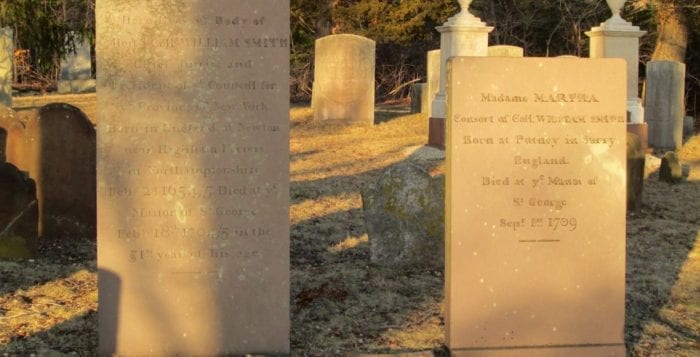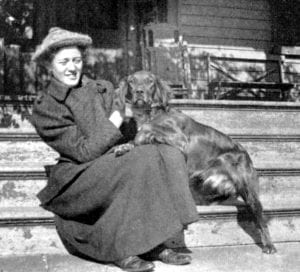By Beverly C. Tyler
She was baptized Martha Tunstall on July 2, 1652, daughter of Henry Tunstall of Putney, Surrey, England. She moved with her family to Tangier, Africa, where she married William Smith. From her marriage on Nov. 26, 1675, until her death in Setauket in 1709 at 57, Martha led a life dedicated to her husband, family, business interests and community. She gave birth to 13 children, buried seven, and journeyed from Tangier back to England, to Ireland for a birth, and finally to America. She raised her family in primitive conditions, assisted her husband in his business dealings, often during his long absences, and became respected as lady of the manor. Widowed at 52, Martha successfully managed her husband’s business interests, including offshore whaling, and became a well-regarded community leader.

Lady Martha Smith, as referred to in many documents, is not listed in The Encyclopedia of Women’s History in America or Long Island Women: Activists and Innovators, both excellent books on overlooked women. However, she was a woman of wealth and influence on Long Island, especially in Setauket and Mastic, where she and William “Tangier” Smith resided.
Colonel William “Tangier” Smith was born in Feb. 1654. Tangier, a key port, was abandoned and burned by England in 1683. William arrived there at 20 and married Martha a year later. He became mayor on Nov. 11, 1682. The couple returned to England in 1683 and, in 1686, sailed from Ireland to America. They arrived in New York in the fall of 1686 with their two children, 7-year-old Henry and 5-year-old Martha. A third child, Hibernia, had died at sea, the couple’s fifth child to die. Three of their children, Elizabeth, John, and William Jr., died in Tangier. Their second William Jr. and Mary died in London.
In New York City, Martha gave birth to Jeane in Dec. 1687. William bought land in Setauket, “Ye Little Neck,” and the south shore. By 1689, the family had moved permanently to Setauket. Martha gave birth to William that March, followed by Gloryana the next year, then Theodocia, who died at 15 days old. Two years later, their last child, Charles Jeffery, was born.
In Setauket, William and Martha moved from their first house near the Woodhull homestead to the Neck, where they built St. George’s Manor. Martha managed the home while William expanded his land holdings. In Oct. 1693, he received a patent from Gov. Fletcher for land bordered by Carmen’s River and Forge River, between Middle Country Road and the Atlantic Ocean. This, combined with previous purchases, created the Manor of St. George. By 1697, he added land extending to Southampton and Southold. The family spent summers at a second manor house on Smith Point, returning to Setauket for the rest of the year. With the 1693 land acquisition, William and Martha became lord and lady of the manor.
As detailed by Kate Strong, “In 1675 (in Tangier), Colonel William Smith began entries in what is now called The First Pigskin Book. The first entry was his marriage. He then recorded baptisms and some deaths of his many children. Writing only on one side of the page, his wife, Martha, turned the book upside down and wrote in her recipes.”
Strong listed a few recipes, including: “To make pancakes—take the yolks of six eggs, add one white, one pint of cream, half a pint of sack, nutmeg, a little salt, and some sugar. Make the batter of a reasonable thickness, work in some flour, and fry them.” Martha also included medicinal recipes: “For a sore throat—take rue, pound it fine, make a poultice, about an inch thick, and lay it on the throat. It is a sure cure. You may sprinkle it with brandy.”
“She was not too busy to enjoy riding with her husband,” Strong related. “I imagine they had fine horses. Their saddles were covered with velvet, hers a side saddle of course.”
When William died in 1705, their children included Henry, later second lord of the manor, age 26; Mrs. Martha Heathcote, 23; Jeane, 17; William Henry, later to inherit the south shore manor, 15; Gloryana, 14, who later married the Rev. George Muirson; and Charles Jeffery, who died of smallpox in 1715 at 11. Lady Martha now had to raise her family and manage her late husband’s holdings and businesses.
Entries in the Pigskin Book recorded Indian whaling crews and whale oil and bone quantities. As noted by Dr. John Strong, “From 1696 until 1721, the Smiths used the book to track Native Americans working for their whaling company. Lady Martha Smith, for the 1706-07 season, made a net profit of 120 barrels of whale oil from 180 barrels—a sizable profit.”
“Offshore whaling was a fine business in those days, and Madam Martha had her own whaleboat,” Strong wrote. “The crew was mostly Indians. She kept records in a second pigskin book, which was almost lost in the San Francisco fire. A family member had taken it west. During the fire, a gentleman found it in a trunk, examined the contents, and returned the book to its owner.”
As noted in Bellport and Brookhaven (1968), “The Lady Martha was remarkable, managing both the vast estate and whaling business successfully.” Kate Strong observed, “Fifteen Indians, the whaling crew, are listed by name; their wages and the charges against them for shot, powder, rum, coats, britches, etc. She must have had trouble controlling them, as there are complaints, such as, ‘He [Will Bene] got nothing this season, stayed away 10 days to see his Shua. Was a great loss to me.’ But there were cheerful entries too: ‘I thank God, my company killed a yearling whale. Made 27 barrels ogle.’”
Early settlers recognized Martha’s prominence, noting that “at the table, no woman except Madam Martha Smith was to sit.” She died five years after her husband on Sept. 1, 1709, and was buried beside him on a spot overlooking the bay at St. George’s Manor.
Beverly Tyler is Three Village Historical Society historian and author of books available from the Three Village Historical Society, 93 North Country Rd., Setauket.







